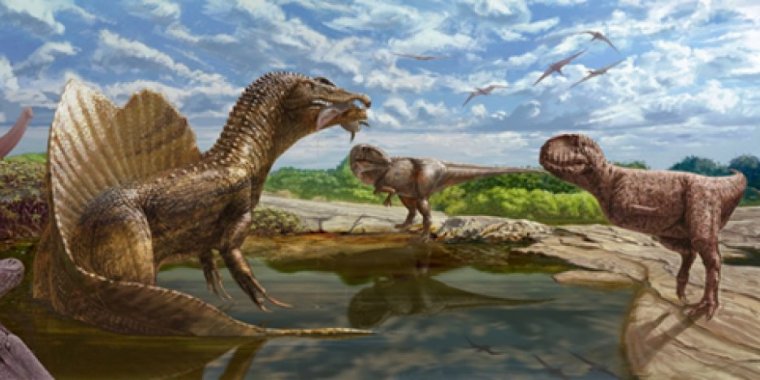| News / Science News |
Bizarre meat-eating dinosaur joins rogues' gallery of giant predators from Sahara Desert
Researchers at Ohio University and other institutions have discovered a new kind of large-bodied meat-eating dinosaur, or theropod, from a celebrated fossil site in Egypt’s Sahara Desert.

Reconstruction of the Bahariya Oasis in the Sahara Desert approximately 98 million years ago. Photo: Andrew McAfee/Carnegie Museum of Natural History
The fossil of a still-unnamed species provides the first known record of the abelisaurid group of theropods from a middle Cretaceous-aged (approximately 98 million years old) rock unit known as the Bahariya Formation, exposed in the Bahariya Oasis of the Western Desert of Egypt.
In the early 20th century, this locality famously yielded the original specimens of a host of remarkable dinosaurs -- including the colossal sail-backed fish-eater Spinosaurus -- which were then destroyed in World War II.
Abelisaurid fossils had previously been found in Europe and in many of today's Southern Hemisphere continents, but never from the Bahariya Formation. The team describes the Bahariya abelisaurid discovery in a paper in Royal Society Open Science.
The fossil, a well-preserved vertebra from the base of the neck, was recovered in an expedition to the Bahariya Oasis.
The vertebra belongs to an abelisaurid, a kind of bulldog-faced, small-toothed, tiny-armed theropod that is estimated to have been roughly 6 meters (20 feet) in body length.
Abelisaurids -- represented by the horned, demonic-looking Patagonian form Carnotaurus of "Jurassic World" and "Prehistoric Planet" fame -- were among the most diverse and geographically widespread large predatory dinosaurs in the southern landmasses during the Cretaceous Period, the final time period of the age of dinosaurs.
Along with Spinosaurus and two other giant theropods (Carcharodontosaurus and Bahariasaurus), the new abelisaurid fossil adds yet another species to the cadre of large predatory dinosaurs that roamed what is now the Egyptian Sahara roughly 98 million years ago.
The new vertebra holds implications for the biodiversity of Cretaceous dinosaurs in Egypt and the entire northern region of Africa.
It is the oldest known fossil of Abelisauridae from northeastern Africa, and shows that, during the mid-Cretaceous, these carnivorous dinosaurs ranged across much of the northern part of the continent, east to west from present day Egypt to Morocco, to as far south as Niger and potentially beyond. (U.S. National Science Foundation)
YOU MAY ALSO LIKE





